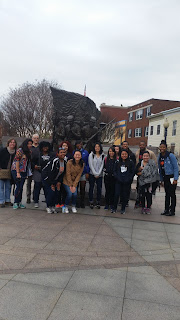 |
| Tyler Lewis talks to the students about The Leadership Conference. |
This morning we drove to K Street to meet with Tyler Lewis, Director of Messaging and Project Management for
The Leadership Conference on Civil and Human Rights. We were also joined by Professor Susan Reed and her students in the Bucknell in DC program. Admittedly, most of us didn't know what The Leadership Conference was or what it does, but it turned out to be very interesting. We tend to associate individual events or movements with the reason that Civil Rights laws get enacted. For example, the Selma to Montgomery march was the primary reason that the Voting Rights Act got passed in 1965. What we learned from Mr. Lewis is that there is a tremendous amount of activity that goes on behind the scenes that help push civil and human rights bills through the political system. The Leadership Conference is a coalition of over 200 organizations that work toward maximizing its members ability to empower and mobilize advocates around the country to push for progressive change as it pertains to civil and human rights. Some of the major issues that they are currently tackling are voting rights, criminal justice issues such as the abolishment of mandatory minimum sentencing an education funding for underserved communities. Mr. Lewis also noted that they are gearing up for lobbying senators to uphold their constitutional obligation and hold confirmation hearings for the nominee that President Obama will be putting forth for the Supreme Court. His comment was "It should be a fun year" as he rolled his eyes. It was about a half hour into his presentation when one of the students mentioned the racial conditions in Central Pennsylvania that he told us that he completely understood since he was a graduate of Lewisburg High School. It turns out that his grandparents were the first blacks to own property in Snyder County when they bought property under the Fair Housing Act in Selinsgrove!
 |
| Lunch at Sankofa Cafe. |
After leaving the Leadership Conference, we took a bus to the
Sankofa Cafe near Howard University for lunch. Sankofa is part cafe, part video store and part book store. It is owned by filmmaker Haile Gerima and is billed as a liberated zone or sanctuary for provocative black film and literature and specializes in books and films about people of African descent around the world.
After lunch, we travelled back to the National Mall and went to the
National Museum of American History to see their Through the African American Lens exhibit. The exhibit was meant to provide an overview of African American history through narratives of various families, organizations and individuals and also provide a preview of the Smithsonian's
National Museum of African American History and Culture that will be opening in the fall of 2016. Some of the students had some very strong opinions regarding the exhibit.
 |
Dunni defends her position while
Brianna looks on. |
After some free time for the students to do some sightseeing, shopping and dinner, we returned back to the 4-H Conference Center for reflection time. We did an activity called Social Barometer. Each corner of the room was designated as Agree, Strongly Agree, Disagree or Strongly Disagree. A statement was made and everybody had to move to the corner that most closely resembles your opinion of that statement. The statement that generated a lot of discussion was
The Through the African American Lens exhibit was presented in the right tone. We each went to a corner and the people that didn't have an opinion or were undecided could stay in the middle. We then had to explain why we held those opinions. After the first round we had the opportunity to move to a different corner if the arguments from the other corners were able to change our opinions. Several students felt that the exhibit was not indicative of the struggles of African Americans and much of the wording in the display descriptions seemed to be inappropriate. One of the conclusions was that the the name of the exhibit was inaccurate because it was presenting African American History through the lens of white Americans to broaden it appeal. The object of the activity was not to really change anybody's mind, but to gain an understanding that people bring different opinions to a situation and that there isn't always a right and wrong and if we disagree with somebody, we can have a discussion might allow us to see both sides of an issue.
 |
| Esmerelda defends her position. |
Tomorrow we pack up and head off to Baltimore to go to the Blacks in Wax Museum and visit the Muslim Community Cultural Center.




























